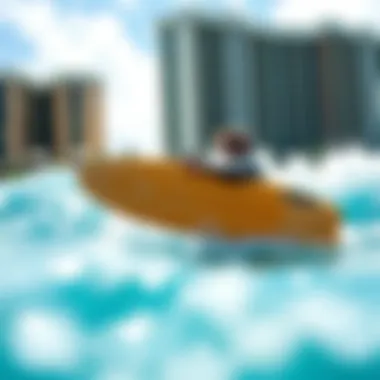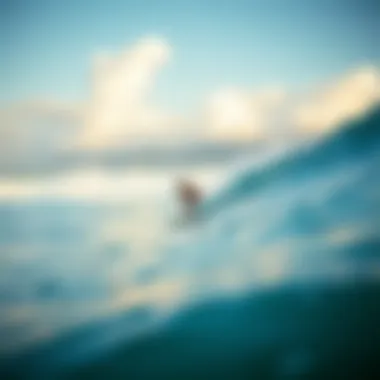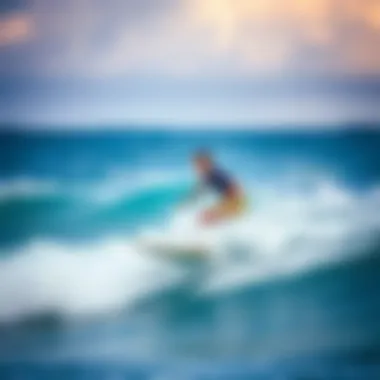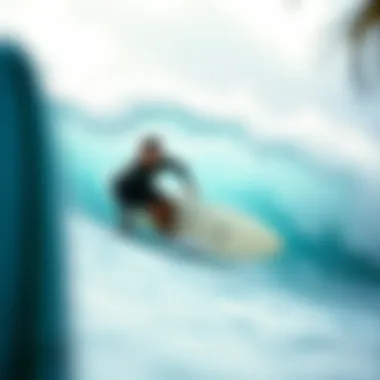The Ultimate Surfing Experience at Waikiki Beach


Intro
Waikiki Beach, a timeless gem nestled on the southern shore of O’ahu, beckons surfers with its gentle waves and enchanting atmosphere. It is more than just a prime surfing destination; it’s an emblem of surf culture steeped in history and community spirit. Whether you’re a gnarled veteran of the waves or a wide-eyed newcomer, Waikiki offers a unique experience that's rich in both challenge and serenity.
Let's dive right into the heart of it—the techniques that make surfing at Waikiki transcendent.
Intro to Waikiki Beach Surf
Waikiki Beach, a gem in the heart of Hawaii, has become synonymous with surfing culture. This introduction sets the stage for understanding why surf enthusiasts from around the globe flock to its golden sands and inviting waves. Known for its gentle swells, Waikiki serves as an ideal playground for both seasoned surfers and those just dipping their toes into the sport.
The significance of this surf spot goes beyond just the thrill of catching waves. It's deeply intertwined with the island’s history, offering a glimpse into the roots of surfing. The beach's sprawling coastlines have cradled generations of surfers, each adding to the narrative of this vibrant locale.
In this article, we’ll dive into the history and culture that shapes the surfing experience here. Readers will discover the values and practices that are second nature to those who ride the waves. By examining the geographical features and seasonal conditions, we shed light on how they influence surfing at Waikiki. Additionally, surf etiquette and equipment essentials are also essential to ensure everyone can enjoy the ocean respectfully and safely.
Waikiki is not just a surf destination; it’s a living tapestry of tradition and community. As we explore different facets, such as the essential techniques or environmental considerations, you will see that every ride is not merely about the wave but about connection to a culture that cherishes the ocean.
"Surfing is not just a sport but a way of life. It's about freedom, connection, and respect for the water."
This article aims to serve both seasoned surfers and newcomers to this beautiful sport with insights into Waikiki’s unique surfing experience.
The Geography of Waikiki
Situated on the southern shores of Oʻahu, Waikiki Beach is an ideal location for surfers of all skill levels. The geography of this iconic beach is not only spectacular to behold, with its stunning beaches and crystal clear waters, but also vitally important for understanding the surfing experience. The unique topography shapes wave dynamics, making it a prime surfing destination, especially for beginners.
Understanding the Shorebreak
The shorebreak at Waikiki serves as both a spectacle and a foundational aspect of the surfing experience. What makes the shorebreak here worth mentioning is its predictability and consistency. As waves approach the beach, they break on the shallow sandy floor, forming relatively safe yet exhilarating conditions for novice surfers. This structure means that the waves build up quickly—allowing for easier paddling and catching, perfect for someone just starting out.
However, catching a wave at the shorebreak demands respect. Surfers must be cautious of the force and speed of the breaking wave. Getting wiped out can happen quickly if one is unprepared. The best advice is to gauge your positioning and take time to observe the waves before heading out.
"Respect the ocean and it will respect you."
Wave Formation and Patterns
Understanding the wave formation and patterns at Waikiki is a crucial piece of the puzzle for surfers. The constant swell from the North and South Pacific Oceans influences the waves hitting the beach, creating a range of sizes and conditions throughout the year.
During the summer months, small, manageable waves dominate, which caters to beginners and encourages them to hone their skills without becoming overwhelmed. In contrast, during winter, the waves tend to grow larger and more challenging, attracting experienced surfers looking for the thrill that only big waves can deliver.
Some key points to consider regarding wave formation include:
- Swells: Waves are typically generated by distant storms. The size and power depend largely on the wind speed, direction, and distance traveled.
- Tides: Notably, the tides influence how waves break. Depending on the tide, the same wave might feel entirely different.
- Seafloor: The configuration of the ocean floor changes the way waves break. In Waikiki, the soft sand bottom helps create gentler waves, in contrast to rocky or coral bottoms elsewhere.
For those aiming to ride the waves at Waikiki, taking a moment to understand these geological elements not only enhances your chances of catching a great wave but also allows for a safer experience on the water. Surfers should familiarize themselves with the timing and patterns of waves by observing the local surf conditions, which can fluctuate dramatically throughout the day.
Ideal Surf Conditions


Understanding ideal surf conditions is vital for anyone looking to ride the waves at Waikiki Beach. Various elements come into play to create the perfect surfing experience, and knowing how to evaluate them can make a world of difference between catching those sweet, rolling waves and ending up in the surf's less welcoming embrace.
Seasonal Variations
Waikiki Beach experiences two main seasons: summer and winter. Each season brings distinct surf characteristics that are worth paying attention to.
Summer (April to September) typically sees smaller, more manageable waves that can be perfect for beginners. The ocean is often calm, allowing for a more relaxed approach to learning. On the flip side, the winter (October to March) can summon massive swells. More experienced surfers will find joy in these challenging conditions, often leading to thrilling rides but also to the necessity of caution.
- Summer:
- Winter:
- Smaller waves, ideal for beginners.
- More tourists, more crowded waters.
- Larger swells, appealing to seasoned surfers.
- Fewer crowds, as some might shy away from the rougher conditions.
It’s not all sunshine and rainbows though; wind patterns also shift with the seasons. Summer usually has a gentle breeze coming from the east. This is beneficial since it helps smoothen the waves. In contrast, winter winds can be quite a bit stronger, which can affect wave quality.
Tidal Influences
Another layer to the surf experience at Waikiki is the influence of tides. Understanding how tides work can greatly improve one's ability to catch waves. At Waikiki, the best surfing often occurs during the incoming tide. This is when the water starts rising, and the waves become fuller and more consistent. Conversely, during a low tide, waves can become steeper and close out quickly.
- Incoming Tide:
- Low Tide:
- Waves tend to have better shape and are more forgiving.
- Perfect for both catching and practicing.
- Surfing can be trickier due to rapid wave closings.
- May require deeper skills to navigate.
Local surfers often have a fine-tuned sense of the tidal schedules. A peak in conditions during tides may necessitate being aware of local forecasts, and relevant resources such as tide charts can guide you. Recommended sites include NOAA Tide Predictions and magicseaweed.com, which can provide up-to-date information to shape your surfing experience.
In summary, tapping into the nuanced understanding of seasonal variations and tides is more than just academic; it’s the key to mastering the waves and having a fulfilling surf session at Waikiki Beach. For anyone looking to embrace this iconic surf culture, recognizing these factors will undoubtedly enhance your time on the water.
Surfing Techniques for Beginners
Starting out in surfing can feel like a daunting task, but grasping fundamental techniques is vital to shaping the overall experience at Waikiki Beach. Whether you're a first-timer or someone looking to refine your skills, understanding basic stances, paddling, and the mechanics of standing up on the board paves the way for a more enjoyable and safe surfing experience. These essentials not only enhance your ability to ride the waves but also focus on safety and confidence in the water, especially in a bustling spot like Waikiki.
Basic Stances and Balance
The cornerstone of surfing effectively lies in mastering your stance. When you first hop on the board, it’s essential to maintain a stance that allows for both balance and mobility. Typically, a surfer stands with feet shoulder-width apart. The toes should point toward the front of the board while bending the knees slightly. This stance gelps to keep your center of gravity low and stable, especially when navigating through choppy water or catching a wave.
- Regular vs. Goofy: Surfers identify as either “regular” or “goofy” based on which foot they prefer at the back. Regular surfers ride with their left foot back, while goofy surfers ride with their right foot back. Finding your stance helps build muscle memory.
- Foot Placement: Experiment with adjusting your foot placement. Even a small shift can drastically change how you control the board. A wider stance can offer more stability, while a narrower stance allows for quicker shifts and turns.
Practicing balancing on the board in calm waters is a good exercise before hitting the waves. Use the beach's surface or practice on a foam board in a pool to get comfortable with shifting your weight.
Paddling and Catching Waves
Paddling is an art form in itself, one that can mean the difference between gliding gracefully on a wave and ending up in the surf zone. At Waikiki, the waves create perfect opportunities to learn how to catch them effectively.


To paddle:
- Position on the Board: Lay down on the board with your chest at the center. Too far back and you'll end up nosediving, too far forward, and you'll struggle against the currents.
- Paddling Technique: Use a fluid motion, alternating arms. The strokes should start from your hip and extend forward into the water, with a quick scoop to pull yourself forward. Think about using your core as well – this helps make paddling less strenuous.
- Catching Waves: Watch the waves closely. Timing is crucial. As the wave approaches, begin paddling hard right before it reaches you. If done correctly, you'll feel a lift under you as the wave picks up your board. This is your cue to prepare for the standing up phase.
Standing Up on the Board
Now comes the moment of truth: getting on your feet. Standing up on the board can create a whirlwind of emotions from thrill to trepidation. Here’s how to do it smoothly:
- Pop Up Motion: From your prone position, push yourself up with a swift motion. Place your hands on the board near your shoulders and spring up into a standing position in one fluid move.
- Foot Placement: As you stand, your feet should land shoulder-width apart, with your knees bent. Keeping your center of gravity low will help maintain balance during this pivotal moment.
- Look Ahead: While it’s tempting to look down at your feet, keep your eyes focused forward. Your body naturally follows where your head faces, which helps maintain balance.
Practicing this on flat ground will bolster your confidence. Even seasoned surfers occasionally practice their pop-up on land to remain sharp.
"Surfing is not just a sport; it’s an adventure, and the techniques taught here are your guide to experiencing the thrill of Waikiki’s waves fully."
Each of these techniques is essential as you embark on your surfing journey at Waikiki Beach. Remember, practice brings improvement, and even the most seasoned surfers keep refining their skills. As you become comfortable with these foundational techniques, the joy of riding waves will soon follow.
Equipment Essentials for Waikiki Surfing
The right equipment makes all the difference when it comes to enjoying the waves at Waikiki Beach. This is more than just a matter of comfort; it's about safety, performance, and ultimately, the joy of riding those iconic Hawaiian waves. Knowing what to choose can seem like trying to find a needle in a haystack, but with a bit of guidance, you can navigate these waters smoothly.
Choosing the Right Surfboard
Selecting the right surfboard is akin to finding a good pair of shoes; it can either make or break your experience on the water. At Waikiki, the waves tend to be gentle and beginner-friendly, making it essential, especially for novices, to pick a board that complements their skill level and objectives.
Longboards are prevalent here since they provide stability and easier paddling. If you’re just starting, consider opting for a soft-top longboard. This type is forgiving and perfect for catching those pesky small waves. In contrast, seasoned surfers may prefer shortboards, known for their maneuverability and speed, particularly if they aim to tackle more challenging waves.
"Selecting a surfboard is a personal journey — your board should feel like an extension of yourself on the waves."
When browsing, pay attention to the size and shape. Width and thickness influence buoyancy; wider boards tend to offer more stability, thus giving you a better chance to pop up once you catch a wave. Additionally, don’t overlook the construction material; epoxy boards are lighter and float better than traditional foam boards, making them easier to handle.
Wetsuits Versus Boardshorts
Now let's talk about what to wear while surfing at Waikiki. This choice could initially seem trivial, but it has significant implications for comfort and performance in the water.
The typical Hawaiian climate is warm, with water temperatures generally hovering around 75°F (24°C), leading many to opt for boardshorts. Perfect for sunny days, boardshorts grant you freedom of movement and allow for a cooler ride. However, depending on the time of year, morning chill or overcast skies may have you reconsidering. In slightly cooler months or if you feel sensitive to temperature, a wetsuit can be your best friend. Wetsuits provide insulation and protection, allowing you to stay in the water longer without feeling the bite of the chill.
Ultimately, the choice between wetsuits and boardshorts boils down to personal comfort and weather conditions. If you're planning on surfing for hours, consider the layering option: lightweight boardshorts combined with a short-sleeve wetsuit top can provide both comfort and warmth.
When in doubt, it's always smart to check the local surf reports for weather conditions before heading out.
In summary, investing time in choosing the right equipment will greatly enhance your surfing experience at Waikiki Beach. The right surfboard will help you catch those waves, while knowing what to wear will keep you comfortable and ready to ride. Remember, the waves at this beautiful beach can be unpredictable, but with the right gear, you'll be prepared to enjoy everything they have to offer.
Local Surf Etiquette
Surfing is more than just a sport; it’s a culture deeply rooted in community and respect. At Waikiki Beach, where waves meet the shore in a dance as old as time, understanding local surf etiquette is crucial for anyone wanting to catch a wave. Knowing how to navigate the waters not only keeps everyone safe but nurtures a sense of camaraderie among surfers. It's about honoring the spirit of aloha that defines Hawaii.


Navigating Crowds Safely
As surfers gear up for a day on the water, it’s important to acknowledge that Waikiki beach can get pretty packed. A crowded surf zone could sound intimidating, but it’s all about the flow. Here are a few points that should guide your experience in navigating through these bustling waves:
- Take turns: If you see another surfer paddling for a wave, let them have it. The surfer closest to the peak of the wave gets the right of way.
- Communicate: If you’re about to drop in, make sure to let others know, like calling out or using hand signals. This helps prevent accidents.
- Look before you leap: Keep an eye on your surroundings as you paddle out. A well-timed observation can prevent a nasty collision.
- Know when to retreat: Not every wave is meant to be ridden. If a wave looks too packed or dangerous, it’s perfectly okay to sit back and wait for another.
Environmental Considerations
The concept of environmental considerations takes center stage when it comes to enjoying and safeguarding the stunning experience at Waikiki Beach. Surfing, while exhilarating, can have a detrimental effect on local ecosystems if not approached mindfully. A balanced relationship between surfers and the environment is essential for the longevity of Waikiki’s natural beauty.
Understanding how we can minimize harmful impacts helps preserve the beach that offers so much to countless enthusiasts each year. \nSurveying the overlap between tourism and the environment, we acknowledge the need for conscious surfing practices that elevate not only the thrill of riding waves but the health of the ocean itself.
Impact of Tourism on Local Ecosystems
Tourism plays a significant role at Waikiki; however, it comes with numerous challenges. Increased foot traffic can lead to beach erosion and degradation of habitats, harming marine life. Pollutants from sunscreen, food, and general waste find their way from visitors to the water, contributing to pollution and affecting the delicate ecosystem.
To tackle these issues, local authorities and organizations promote awareness about eco-friendly practices. Educating visitors on responsible behavior helps protect both the beach and its surrounding waters. Here are a few ways tourism impacts local ecosystems:
- Concentration of Surfers: When too many surfers congregate in a small area, it can lead to localized damage to coral reefs and sea life.
- Waste Management: Not disposing of trash properly can contaminate the ocean and harm wildlife.
- Destructive Practices: Some may engage in practices like using non-eco-friendly boards or careless snorkeling near coral, causing further damage.
Effective stewardship from the surfing community and tourists alike can mitigate damage while maintaining enjoyment.
Sustainable Surf Practices
To foster a sustainable surfing experience, enthusiasts are increasingly adopting practices that conserve and protect natural resources. This isn't just good for the ocean; it enhances the surfing experience overall. Here are fundamental sustainable practices surfers can apply:
- Use Eco-Friendly Sunscreens: Biodegradable sunscreens prevent harmful chemicals from entering the water.
- Respect Guidelines: Follow local environmental regulations and beach rules to help maintain a healthy ocean.
- Choose Sustainable Equipment: Opt for surfboards made from eco-friendly materials, which reduce your carbon footprint.
- Participate in Clean-Up Events: Take part in organized beach clean-ups to give back to the community by cleaning up debris that may have washed ashore.
- Support Local Eco-initiatives: Local organizations often run programs aimed at conservation; supporting them heightens awareness and facilitates change within the community.
A commitment to these practices ultimately results in well-preserved waves and a thriving ocean ecosystem for everyone to enjoy. \n
"We don't inherit the earth from our ancestors; we borrow it from our children."
Remember, our actions today echo in the waves of tomorrow.
Closure
The concluding section of our exploration into surfing at Waikiki Beach holds significant importance. This area has not only shaped surf culture but has also inspired countless individuals from all walks of life to connect with the ocean. Understanding its future and how we, as responsible surfers and community members, can contribute to preserving this iconic location is essential.
The Future of Waikiki Surfing
The future of surfing in Waikiki hinges on several factors, particularly the balance between enjoyment and sustainability. As tourism increases, maintaining the delicate ecosystem becomes ever more crucial. Local organizations and surfing clubs are paving the way for promoting sustainable sugar practices through education and community outreach. It is vital for surfers and visitors alike to recognize the importance of respecting our shared environment.
In the upcoming years, advanced technologies may change how surfers interact with waves. Devices for monitoring ocean conditions, sustainable surfboards made from eco-friendly materials, and better education on environmental impacts will become prevalent. Embracing these advancements while keeping traditions alive will ensure that Waikiki remains a beloved surfing destination.
Continuing the Surf Legacy
Continuing the rich legacy of Waikiki surfing means more than just riding the waves. It's about fostering a culture that respects the ocean, honors the history, and promotes inclusivity among all surfers. The local community plays a critical role in keeping surfing a diverse and welcoming sport. Some young surfers are making waves by combining surfing with art, sharing personal stories, and advocating for ocean preservation through different platforms.
Inclusivity is fundamental. The Waikiki beach experience should be approachable for everyone, regardless of skill level or background. Programs that provide free or low-cost surfing lessons to locals and visitors alike can help build a sense of community and encourage innovation. As surfers work together to sustain not only their sport but also their environment, they create a legacy that will inspire future generations to cherish the unique locale of Waikiki.
"Surfing isn't just a sport here; it's a way of life that reflects our connection with the ocean and each other."
By engaging in these practices and fostering a spirit of camaraderie, the surfing community at Waikiki will continue to thrive, ensuring that it remains at the forefront of surf culture for many years to come.















